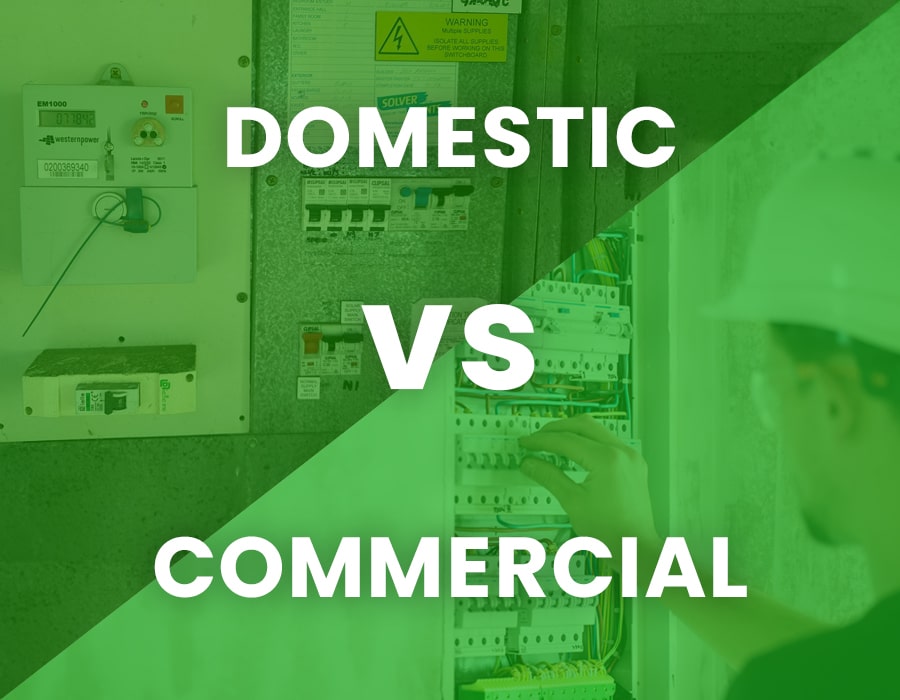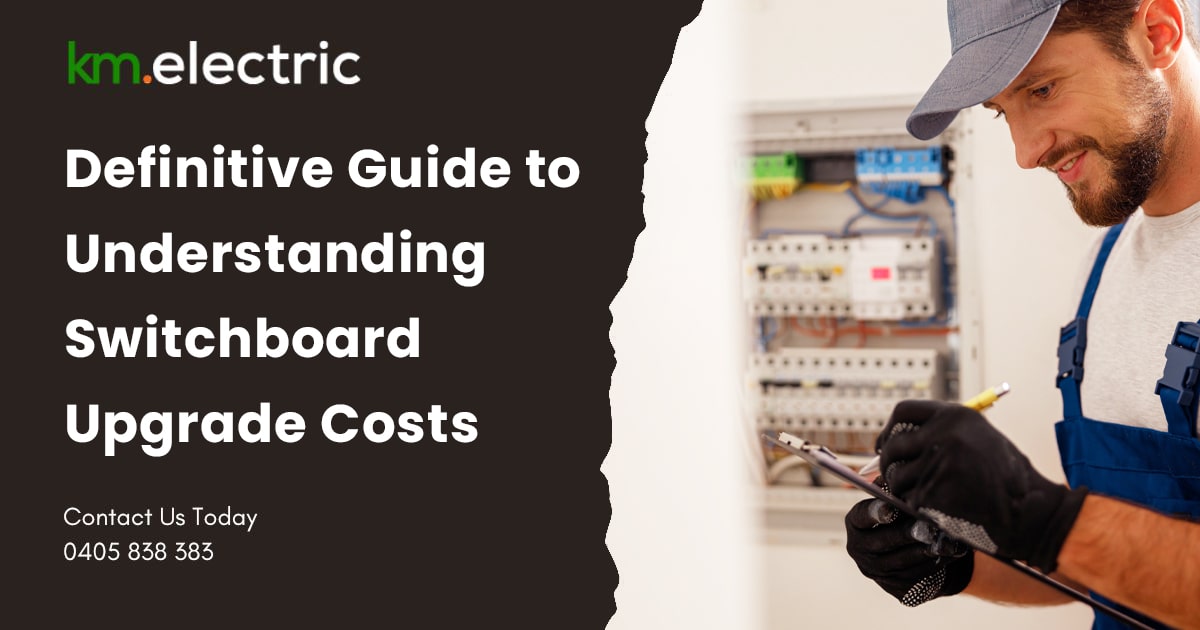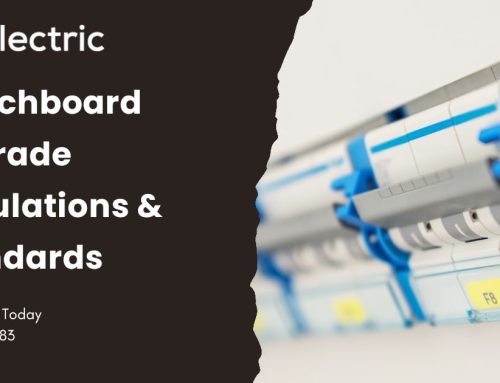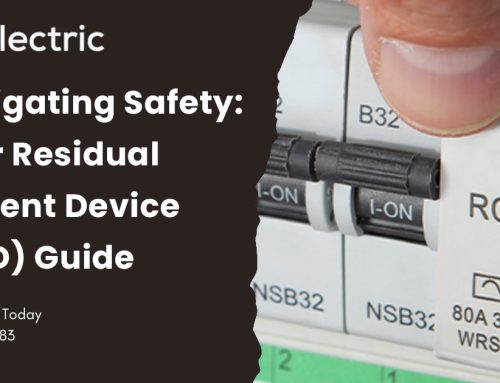If your house or business premises is due for a switchboard upgrade, one of your likely concerns would be the budget you’ll need to cover this expense. And this is perfectly understandable.
In this blog post, we’re cutting through the clutter to discuss a topic that demands clarity: switchboard upgrade costs or the total expense associated with electric switchboard upgrades in Australia.
No frills, just the facts you need to make an informed decision. Because at KM.Electric, we believe that customers’ uncertainties about the cost to upgrade their switchboard shouldn’t get in the way of them making a choice to prioritise such an essential aspect of their property.
We’ll break down the key factors influencing costs, offer practical insights, and shed light on the value that a well-executed switchboard installation brings to your property. Let’s demystify the expenses, empowering you to embark on this essential journey with confidence and transparency.
How Much Does a Switchboard Upgrade Cost?
Whether you want to future proof your home, plan to add a solar panel system to support the energy requirements of your business, or are using a lot of appliances or machinery with high-energy requirements, a switchboard upgrade may be necessary.
Other reasons to upgrade your switchboard include receiving an electrical defect notice or you’re making changes or upgrading your electrical system.
Of course, you’ll need to set a budget for this, but how much does it cost to replace a switchboard?
When it comes to switchboard upgrades in Australia, costs vary based on several factors.
On average, residential upgrades may range from $800 to $2,000 plus GST, while commercial upgrades can extend from $2,000 to $5,000 plus GST or more. These figures encompass materials, labour, and other additional expenses, offering an average ballpark estimate for property owners to consider.
However, please note that it does not include rewiring and cabling costs, which can be a significant additional expense (discussed further below).
How Are Switchboard Upgrade Costs Calculated?
Embarking on a switchboard upgrade requires a clear understanding of the associated costs.
From the materials and labour that form the backbone of an upgrade to additional fees like permits and inspections, there are several key factors that determine the investment you’ll need to make to enhance your property’s electrical infrastructure and ensure the safety of your appliances or equipment and occupants.
New Switchboard (Material and Parts)
The cost of materials, including the switchboard itself, circuit breakers, safety switches, and other essential components, typically ranges from $500 to $1,500.
Note that electrical switchboard prices usually vary based on their make or quality and the features of their components.
Electrician Labour Costs
Labour costs constitute a significant portion of the total cost of a switchboard upgrade, on average ranging from $300 to $1,000, depending on the rate of the electrician and complexity of the upgrade. However, please note that the total labour cost can reach up to around $3,000 or more if your property necessitates rewiring and cabling.
Remember that you’ll need a licensed electrician with the experience and skills to handle your project to ensure a safe and effective installation.
Additional Fees (Permits, Inspections)
Extra expenses such as the fees associated with securing permits and scheduling inspections can vary, generally falling between $200 and $500 plus GST.
Local regulations may impact the necessity and cost of permits, while inspections ensure compliance with safety standards.
The specific permits and inspections required for switchboard upgrades can vary depending on the state or territory regulations and the complexity of the work. However, some common requirements include:
- Electrical Work Permit: This ensures that the work complies with safety standards and is performed by licensed and qualified electricians.
- Inspection by an Electrical Regulator: After the completion of the switchboard upgrade, an inspection by the relevant electrical regulator or authority may be necessary. This inspection verifies that the work aligns with the applicable electrical standards and regulations.
- Certificate of Compliance: Issued after a successful upgrade, this certificate confirms that the switchboard upgrade has been completed in accordance with safety standards and regulatory requirements.
- Local Council Approval: Depending on the extent of the upgrade and local regulations, approval from the local council may be required. This is more common for larger or more complex projects that may impact the overall electrical infrastructure.
- Notification to Electrical Distributor: In some cases, the electrical distributor responsible for the supply of electricity to the property may need to be notified of the switchboard upgrade. This ensures coordination and compliance with grid connection requirements.
Cabling and Rewiring Costs
Replacing Network Cables (External)
In certain instances, there may be a need to replace cables extending from the overhead supply to the Point of Attachment (POA) and from the POA to the service fuse within the switchboard if they fail to meet established standards.
The cost of replacing these network cables can vary, ranging from $1,000 to $3,000 for residential properties and $3,000 to $5,000 for commercial properties. It’s important to note that this cost may differ by state due to variations in rules and regulations regarding who is authorized to carry out this specific type of work.
Given the differences in regulations, licenses, and guidelines across states, the cost of such replacements may vary based on the specific requirements and qualifications stipulated by each state.
For instance, in New South Wales (NSW), licensed Level 2 electricians are required to perform this type of work. In Victoria (VIC), A Grade electricians are qualified for the task, while in Western Australia (WA), electrical contractors are authorised to undertake such work. Each state has distinct regulations, licenses, and guidelines specifying who is authorised to conduct cabling work of this nature.
Property Rewiring (Internal)
If your property requires rewiring, it can incur additional costs, especially if it has old wiring that may not comply with Australian Standards. Homes over 40 years old should typically undergo rewiring, and even newer homes may necessitate it under certain circumstances.
- Signs that your house may need rewiring include:
- Hot or discoloured power points
- Buzzing and sizzling sounds
- A burning smell
- Sparks or minor electrical shocks when plugging in appliances
While rewiring can be an investment, it’s considerably less costly than potential fire damage. Rewiring of your property may range from $4,000 to $8,000.

Domestic vs Commercial Switchboard Upgrade Cost
The cost of upgrading switchboards in domestic and commercial settings generally entail different costs primarily because of the difference in the size and complexity of each project.
The scale of commercial systems and the intricacies of their electrical demands typically mean more cost considerations for business or commercial property owners.
Domestic Switchboard Costs
Because of their smaller capacity and less complex systems, domestic switchboard upgrades tend to be more affordable, ranging from $800 to $2,000 on average.
Commercial Switchboard Costs
Commercial switchboard upgrades, catering to higher power demands and complexity, have a broader range, averaging between $2,000 and $5,000 (or higher) because. The scale and intricacy of commercial systems contribute to this variance in costs.
Factors Influencing Costs
Understanding the factors that influence the costs of electric switchboard upgrades is essential for property owners to know exactly how much they need to invest in their project.
Let’s explore key considerations that can impact how much you’ll need to spend on your switchboard upgrade.
Property Size and Type
Larger properties with higher electricity demands may require a switchboard with a greater capacity as well.
- Voltage and Amperage: The voltage and amperage needs of a property influence the specifications of the switchboard.
- Number of Spaces: The quantity of electrical circuits and devices will determine the size of the switchboard.
- Dimensions and Enclosure: Larger switchboards or those requiring specialised enclosures can contribute to increased costs.
Switchboard Type
Choosing the right type of switchboard—whether it’s air-insulated, metal-enclosed, or cast resin—requires a careful assessment of your specific needs and property characteristics. Here’s a breakdown to help you make an informed decision:
Air-Insulated Switchboards
These switchboards use ambient air as the insulating medium to protect and control electrical circuits. Air-insulated switchboards are commonly used in various applications, including industrial facilities, commercial buildings, and utility substations.
Advantages:
- Cost-effective and simpler in design.
- Suitable for smaller installations with lower power demands.
Considerations:
- Limited capacity for larger properties or commercial spaces.
- May have restrictions in high-demand scenarios.
Best Suited For:
- Residential properties with moderate power requirements.
- Small to medium-sized commercial establishments.
Metal-Enclosed Switchboards
Metal-enclosed switchboards are designed for the safe and controlled distribution of electrical power. These switchboards are enclosed within a metal housing, providing protection to the internal components and enhancing safety.
Advantages:
- Durable and provide enhanced protection.
- Ideal for larger installations with higher power demands.
Considerations:
- Higher upfront cost compared to air-insulated switchboards.
- More complex design, potentially requiring more maintenance.
Best Suited For:
- Larger residential properties with higher energy demands.
- Commercial and industrial facilities with substantial power requirements.
Cast Resin Switchboards
Also known as resin-insulated switchboards or cast resin transformers, cast resin switchboards are a type of electrical switchgear that uses epoxy resin as an insulating material to protect and control electrical circuits. These switchboards are commonly employed in various applications where safety, reliability, and environmental considerations are paramount.
Advantages:
- Superior safety features and performance.
- Resistant to environmental factors such as moisture and dust.
Considerations:
- Higher initial cost compared to other types.
- May have specific installation and maintenance requirements.
Best Suited For:
- Environments with challenging conditions (moisture, dust).
- Critical applications where safety and performance are top priorities.
Location (Urban vs Rural)
It may not make total sense at first, but here’s how your location can affect the cost of your switchboard upgrade.
- Urban Areas: Accessibility and proximity to suppliers may contribute to more competitive pricing.
- Rural Areas: Limited accessibility can result in higher transportation costs for materials and services.
Existing Electrical Infrastructure
The existing electrical infrastructure significantly impacts the cost of a switchboard upgrade for several reasons:
- Compatibility and Integration: The new switchboard must seamlessly integrate with the existing electrical system. If the existing infrastructure is outdated or incompatible, modifications may be required to ensure proper integration.
- Wiring and Connection Adjustments: In some cases, the upgrade may necessitate changes to the wiring or connections within the property. Adapting the new switchboard to the existing wiring may involve additional labour and materials.
- Capacity and Load Assessment: The capacity of the existing electrical system must align with the demands of the upgraded switchboard. If the current infrastructure lacks the capacity to support the upgraded switchboard, upgrades or enhancements may be needed.
- Safety and Compliance Upgrades: Older electrical systems may not meet current safety standards and switchboard upgrade regulations. Upgrading the switchboard provides an opportunity to address any safety deficiencies in the existing infrastructure, but this may incur additional costs.
- Technology and Component Compatibility: Advancements in switchboard technology may require updates to other components in the electrical system for compatibility. Ensuring that new components work seamlessly with existing ones may involve additional adjustments and costs.
- Upgrading to Modern Standards: The existing infrastructure might be based on outdated standards. Bringing the entire system up to modern standards may involve additional work and materials to meet current regulations.
- Unforeseen Challenges: During the upgrade process, unforeseen challenges related to the existing infrastructure may arise. Addressing unexpected issues may require additional time, labour, and materials.
- Efficiency and Optimisation: An efficient switchboard upgrade considers how the new system can optimise the overall electrical infrastructure. Adjustments to the existing infrastructure may be necessary to achieve optimal performance and efficiency.

Switchboard Upgrade Cost by City
Curious about how location impacts the cost of electric switchboard upgrades?
We’re breaking down the numbers by city, providing insights into the regional variations that property owners need to consider when budgeting for this essential upgrade.
Switchboard Upgrade Cost in Sydney
Sydney’s bustling urban landscape can influence costs. With a high demand for electrical services, expect competitive pricing. Average switchboard upgrade costs in Sydney range from $800 to $2000, but variables like property size and existing infrastructure can contribute to variations.
Switchboard Upgrade Cost in the Gold Coast
The coastal charm of the Gold Coast can reflect in switchboard upgrade costs. Ranging from $900 to $2,200, factors like proximity to suppliers and the local economy play a role. Efficiency and safety are paramount considerations in this picturesque locale.
Switchboard Upgrade Cost in Brisbane
Brisbane sees average switchboard upgrade costs between $850 and $2,100. Regional dynamics, supplier accessibility, and the demand for electrical services contribute to the variations.
Switchboard Upgrade Cost in Melbourne
Melbourne, a hub of culture and industry, presents switchboard upgrade costs averaging between $850 and $2,000. The city’s size and demand for electrical services are key factors influencing switchboard upgrade expenses.
Switchboard Upgrade Cost in Perth
Perth’s unique location on the west coast can impact switchboard upgrade costs, ranging from $900 to $2,200. Factors like supplier accessibility, the local economy, and demand for electrical services contribute to the regional variations.
Possible Additional Costs To Be Aware Of
Electric switchboard upgrades often come with potential additional costs that property owners should be mindful of. Let’s go over each one of these considerations:
Call-Out Fees
Call-out fees are charges incurred when an electrician is summoned to assess or address an issue. These fees cover the electrician’s time (usually dependent on how much they charge per hour), travel, and initial assessment, adding to the overall upgrade cost.
Call-out fees typically range from $50 to $150. While seemingly minor, they contribute to the overall expense and are an essential factor to consider when budgeting for switchboard upgrades.
New Cables and Rewiring
Upgrading cables and rewiring requires careful consideration, especially when choosing between a single-phase 80-amp or a 3-phase 240-amp switchboard for your house. Both switchboards necessitate 16mm² cables from the mains supply, while cables from the switchboard into the property range from 1.5mm to 6mm.
An 80-amp single-phase switchboard is suitable for smaller properties, while a 240-amp 3-phase switchboard caters to settings with elevated electrical demand. For an 80-amp switchboard, 1.5mm² cables may suffice, but a 240-amp switchboard might require up to 6mm² cables for optimal performance.
In commercial settings, the choice of switchboard also depends on electrical demand. The single-phase switchboard typically has an 80-amp capacity, like residential properties. However, a commercial 3-phase switchboard usually holds a 400-amp capacity, designed for larger commercial requirements. The cabling for both switchboards includes a 25mm² mains supply, with outgoing circuits into the property ranging from 1.5mm² to 10mm².
The Need for a New Circuit Breaker, Safety Switch or RCD
Integrating new circuit breakers, safety switches, or residual current devices (RCDs) enhances safety but can add to the total cost of your switchboard upgrade project.
- Circuit breakers protect against overloads.
- Safety switches swiftly cut power during faults.
- RCDs prevent electric shocks.
These components work in tandem to ensure you have a safe, secure electrical system. For instance, a circuit breaker may trip during an overload, triggering the safety switch to disconnect power, while an RCD adds an extra layer of protection.
How Much Does a 3-Phase Switchboard Upgrade Cost?
Considering a 3-phase switchboard upgrade? Let’s break down the essentials:
What Is a 3-Phase Switchboard?
A 3-phase switchboard manages electrical power distribution in three alternating currents.
Unlike single-phase systems, it accommodates heavier electrical loads, making it ideal for larger properties or commercial spaces.
Components and Capacity
Comprising three live wires, a 3-phase switchboard can handle more significant power demands. Common components include circuit breakers, safety switches, and meters, ensuring efficient and balanced distribution.
Suitable Properties
Best suited for larger homes, industrial settings, or commercial establishments with substantial electrical requirements, a 3-phase switchboard ensures a robust and reliable power supply.
Why Choose a 3-Phase Switchboard?
Opting for a 3-phase system enhances power distribution efficiency, reduces the risk of overload, and accommodates the diverse needs of machinery and equipment in commercial settings.
Factors Impacting Total Cost
The total cost of a 3-phase system depends on property size, existing infrastructure, and the complexity of the upgrade.
Larger properties with extensive electrical needs may incur higher costs, but the efficiency and capacity of a 3-phase switchboard justify the investment for properties with substantial power requirements.
Why km.electric Is Sydney’s Top Choice for Switchboard Installation and Replacement
When it comes to your electrical infrastructure needs in Sydney – including switchboard installation and upgrades – it’s in your best interest to work with an experienced, reliable and flexible provider.
km.electric ticks all the right boxes.
We have over two decades of experience working in a range of neighbourhoods and communities in Sydney. Our technical team is fully licensed, ACMA registered, with a security master licence for security system installations.
We’re available 24/7 to attend to your requirements.
Call us today on 0405 83 83 83






